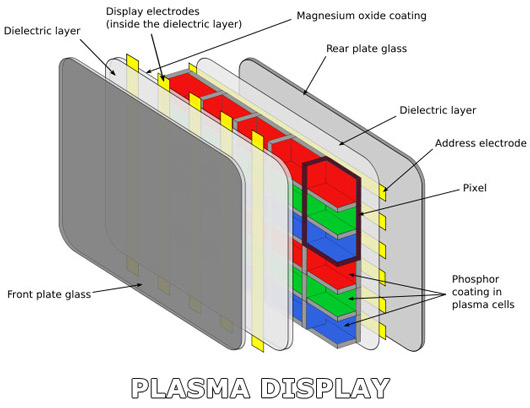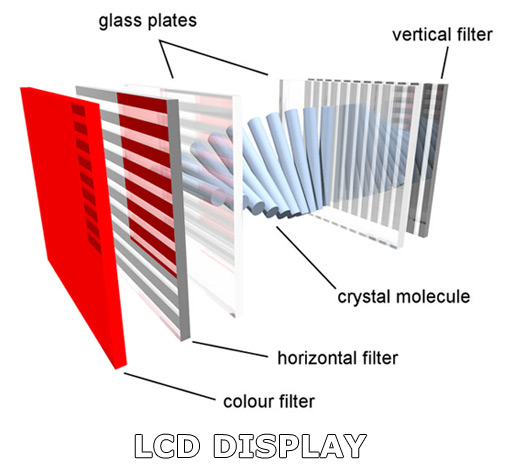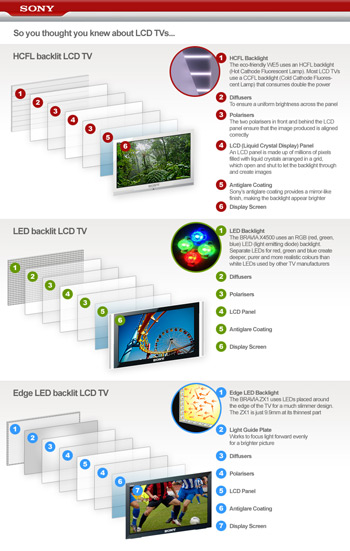A Guide to HDTVs
[Page 4] LCD vs. Plasma
Let's turn to perhaps the biggest area of contention and confusion for the average HDTV buyer: the type of display technology to choose. At present there are two major types of display technology which are commonly used in the consumer HDTV arena: Plasma TV and LCD TV. Within the LCD category, there are various types of displays, including the more recent LED-backlit LCD displays.
It should be noted at this point that the Projectors category, which includes Rear Projection TV (RPTV), is not discussed in this article. Front projectors are a perfectly valid choice for home theater enthusiasts, especially those who want the largest screen real estate. But they are not included in this guide simply because they are not as convenient nor as versatile as flat panel displays. Projectors are more suited to specialist home theater applications requiring fairly strict control over the light in the viewing environment. Rear projection TVs are more convenient in this respect, but have been almost completely phased out of production, and are also not discussed. A fourth display type which you may have heard about, called Organic Light Emitting Diode (OLED), is extremely expensive and not yet produced in large enough screen sizes to be considered a genuine proposition for HDTV buyers. OLED is discussed in more detail under Future Technology in the Conclusion section of this guide.
So it boils down to the classic LCD vs. plasma war which wages daily on the Internet. As mentioned in the Introduction to this guide, there is currently no perfect display technology, and none is on the horizon. This guide doesn't pretend to resolve the LCD vs. plasma debate; each of these display types has its pros and cons, and requires a level of compromise. The only way you can make the choice is by understanding the technologies involved, the technical specifications and what they really mean, the various quirks and issues of each, and thus the suitability of these displays to your particular circumstances.
The Underlying Technology
As we'll soon come to see, every pro and con for LCD and plasma derives from the underlying technology they use. These two display types may look similar when sitting side-by-side in a store, but they're very different in the way they approach the reproduction of video.
Plasma

A Plasma TV earns its name from the fact that the primary component used to generate light output is a highly charged gas known as plasma. A plasma screen is made up of a grid array of small gas-filled cells which are very similar to neon lights. Each plasma pixel consists of a set of three of these phosphor-coated cells called sub-pixels, one for red, green and blue respectively. The charged gas in a cell lights up the phosphor coating inside it, producing the relevant colored light. These lit pixels shine through a glass panel to display an image.
Plasma TV has a lot in common with the traditional CRT TV many of us grew up with. In a CRT, an electron gun at the back of the set shoots beams at a glass screen coated with phosphors to produce light, and there are red, green and blue phosphors to produce a color image.
LCD

An LCD TV has a grid array of small liquid crystals which can each change shape, twisting to allow various amounts of the light shining from behind them to come through and help produce an image on the screen. Each pixel in an LCD display is made up of three sub-pixel crystals, one for red, green and blue respectively. The light shining from behind the crystals is called Backlighting, and traditionally, LCD displays have used Cold Cathode Fluorescent Lamps (CCFL). The introduction of Light Emitting Diodes (LED) as the backlighting for LCD displays has improved the way in which they can perform but has somewhat inaccurately earned them the title of LED TVs. This gives the impression that the screen is made up of LED lights, which is false. The correct term is LED-backlit LCD TV, or LED-LCD for short. There are two main types of LED-backlit LCD displays (Full Array and Edge-lit) and one associated factor (Local Dimming) which can apply to either as covered below:
So in summary, plasma is a self-emitting technology because it creates light directly within each pixel. LCD works on the opposite principle, with each pixel filtering the light from a source shining from behind the pixel. The commonality between plasma and LCD-based displays is that they're both relatively thin, hence the name flat panel, and they're both fixed-pixel digital displays with red, green and blue sub-pixel structures. It's their differences however that make them more or less suitable to certain applications, and this is what we examine throughout the rest of the guide.

